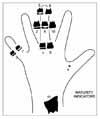1. Lee JH, Kang YG, Lee KS, Nam JH. Maturation of cervical vertebrae in relation to menarche. Korean J Orthod. 2009. 39:28–35.

2. Lee KH, Hwang YI, Kim YJ, Park YH, Baek SH, Cha KS. Skeletal maturation associated with the fourth cervical vertebra and menarcheal timing. Korean J Orthod. 2008. 38:52–59.

3. Bishara SE, Jamison JE, Peterson LC, DeKock WH. Longitudinal changes in standing height and mandibular parameters between the ages of 8 and 17 years. Am J Orthod. 1981. 80:115–135.

4. Fishman LS. Maturational patterns and prediction during adolescence. Angle Orthod. 1987. 57:178–193.
5. Chertkow S, Fatti P. The relationship between tooth mineralization and early radiographic evidence of the ulnar sesamoid. Angle Orthod. 1979. 49:282–288.
6. Demirjian A, Buschang PH, Tanguay R, Patterson DK. Interrelationships among measures of somatic, skeletal, dental, and sexual maturity. Am J Orthod. 1985. 88:433–438.

7. Sierra AM. Assessment of dental and skeletal maturity. A new approach. Angle Orthod. 1987. 57:194–208.
8. Hägg U, Taranger J. Maturation indicators and the pubertal growth spurt. Am J Orthod. 1982. 82:299–309.

9. Fishman LS. Radiographic evaluation of skeletal maturation. A clinically oriented method based on hand-wrist films. Angle Orthod. 1982. 52:88–112.
10. Lamparski DG. Skeletal age assessment utilizing cervical vertebrae. 1972. Pittsburgh (PA): University of Pittsburgh;[master's thesis].
11. Hellsing E. Cervical vertebral dimensions in 8-, 11-, and 15-year-old children. Acta Odontol Scand. 1991. 49:207–213.

12. Hassel B, Farman AG. Skeletal maturation evaluation using cervical vertebrae. Am J Orthod Dentofacial Orthop. 1995. 107:58–66.

13. Lauterstein AM. A cross-sectional study in dental development and skeletal age. J Am Dent Assoc. 1961. 62:161–167.

14. Engström C, Engström H, Sagne S. Lower third molar development in relation to skeletal maturity and chronological age. Angle Orthod. 1983. 53:97–106.
15. Lewis AB, Garn SM. The relationship between tooth formation and other maturational factors. Angle Orthod. 1960. 30:70–77.
16. Green LJ. The interrelationships among height, weight and chronological, dental and skeletal ages. Angle Orthod. 1961. 31:189–193.
17. Banks HV. Incidence of third molar development. Angle Orthod. 1934. 4:223–233.
18. Demirjian A, Goldstein H, Tanner JM. A new system of dental age assessment. Hum Biol. 1973. 45:211–227.
19. Olze A, Bilang D, Schmidt S, Wernecke KD, Geserick G, Schmeling A. Validation of common classification systems for assessing the mineralization of third molars. Int J Legal Med. 2005. 119:22–26.

20. Arany S, Iino M, Yoshioka N. Radiographic survey of third molar development in relation to chronological age among Japanese juveniles. J Forensic Sci. 2004. 49:534–538.

21. Bolaños MV, Moussa H, Manrique MC, Bolaños MJ. Radiographic evaluation of third molar development in Spanish children and young people. Forensic Sci Int. 2003. 133:212–219.

22. Kullman L, Johanson G, Akesson L. Root development of the lower third molar and its relation to chronological age. Swed Dent J. 1992. 16:161–167.
23. Demisch A, Wartmann P. Calcification of the mandibular third molar and its relation to skeletal and chronological age in children. Child Dev. 1956. 27:459–473.

24. Krailassiri S, Anuwongnukroh N, Dechkunakorn S. Relationships between dental calcification stages and skeletal maturity indicators in Thai individuals. Angle Orthod. 2002. 72:155–166.
25. Moorrees CF, Fanning EA, Hunt EE Jr. Age variation of formation stages for ten permanent teeth. J Dent Res. 1963. 1490–1502.

26. Mincer HH, Harris EF, Berryman HE. The A.B.F.O. study of third molar development and its use as an estimator of chronological age. J Forensic Sci. 1993. 38:379–390.

27. Gorgani N, Sullivan RE, DuBois L. A radiographic investigation of third-molar development. ASDC J Dent Child. 1990. 57:106–110.
28. Nanda RS. Eruption of human teeth. Am J Orthod. 1960. 46:363–378.

29. Garn SM, Lewis AB, Bonné B. Third molar formation and its development course. Angle Orthod. 1962. 32:270–279.
30. Nanda SK. Patterns of vertical growth in the face. Am J Orthod Dentofacial Orthop. 1988. 93:103–116.

31. Janson GR, Martins DR, Tavano O, Dainesi EA. Dental maturation in subjects with extreme vertical facial types. Eur J Orthod. 1998. 20:73–78.





 PDF
PDF ePub
ePub Citation
Citation Print
Print











 XML Download
XML Download